Codemasters makes its first push for PlayStation 5 Pro support with an update to F1 24 – a release that adds ray tracing upgrades and integrates the machine’s PSSR upscaling. Of course, F1 24 already has an impressive set of modes on the regular, base PS5, including support for 120fps gaming – and the same quality/performance divide remains on Pro, but with a range of enhancements for each. There’s also a new ‘resolution’ mode that unlocks only when the Pro is connected to an 8K screen. We went hands on at the studio on PS5 Pro development hardware and while the code wasn’t quite final, the upgrade is clearly impressive, particularly in the 60fps quality mode, where the EGO engine’s ray tracing features are used extensively.
A range of RT upgrades are in place. Whereas the standard PS5’s quality mode only used ray tracing in replays and pre-race sequences, PS5 Pro changes all of that. In large part thanks to the leeway afforded by its more capable GPU – a 67 per cent increase in compute units, and 28 per cent boost in memory speeds – it’s now possible to include three RT features during the race itself, all while still running at 60 frames per second. There’s ray traced reflections, including opaque materials like glass, alongside ray traced ambient occlusion for more realistic indirect shading and dynamic diffuse global illumination – or DDGI – allowing for simulated light bounce between surfaces. The one RT option missing during gameplay is ray traced shadows, though these are enabled during in-engine cinematics.
In comparing the base PS5 directly to PS5 Pro, the ray tracing upgrade for reflections is a substantial one. The overcast afternoon sky is more accurately reflected across the glossy surface of the car, and even the driver’s helmet. Each surface is more thoroughly lit in daylight, as it would be in a real race. The other, classic example of ray traced reflections is on wet track surfaces. The base PS5 uses the screen-space method – SSR – to draw reflections, where every roadside barrier and overhead billboard is vibrantly mirrored across the tarmac. Except, the result is often exaggerated. SSR works well, but it doesn’t simulate the way real-life light reacts, and crucially diffuses, across rough surfaces. The material reaction is too clean in the mirroring of elements above the track.
With RT on PS5 Pro, reflections are more true-to-life in factoring in the way light hits the coarse material properties of the road. It works much like the PC version maxed out in this sense. The impact of light from road-side barriers is undeniably subtler with RT engaged. Still, overall, PS5 Pro offers a more natural result via RT, where the most reflective points on the road are typically puddle formations.
Next along is the impact of ray traced ambient occlusion – the indirect shading in and around the car and track. The underside of the car has a more realistic, deeper blanket of shade and even trackside detail is more accurately shaded. Racing through the Azerbaijan circuit around dusk, the waning sunlight is better simulated with PS5 Pro’s RTAO: its barriers are darkened all the way up the initial strait, while the base model’s details look almost artificially bright. There’s an altogether richer, more natural pass of shade that beds in every point of the track ahead, and even cockpit details.
Finally, we also have PS5 Pro’s DDGI – the dynamic diffuse global illumination. Previously this was best shown off on base PS5 around the car showrooms of the main menu – running at 30fps – but never in gameplay. As you’ll see in the embedded video on this page, the ambience is transformed with DDGI, but ultimately, the takeaway here is that all of the RT features combine to create a more visually accurate image – without sacrificing the original quality mode’s 60 frames per second target.
Sony’s machine learning-driven PlayStation Spectral Resolution (PSSR) makes all of this happen. There’s no such thing as a free lunch in rendering and RT in particular is computationally expensive. The actual, native resolution is changed compared to a base PS5 – which typically runs at dynamic 4K, with drops to 1800p. In PS5 Pro’s case, the native resolution is lowered to a range of 1440p to 1080p instead, always adjusting based on rendering load, and the demands of ray tracing per track. To pick one example, pixel tests on a complex stage like Monaco come in at 1224p – or 56 per cent scale of 4K – but that does go higher and lower. PSSR is the magic bullet here: there are enough raw pixels to work with, to resolve the track and car details to a surprisingly comparable 4K result. Quality of pixels vs quantity of pixels, with machine learning makes up the difference in terms of the perception of higher resolution.
In pure image quality terms this PSSR reconstruction ends up coming close to the base PS5’s native 1800p-4K image. There are inevitably some limits as a result though, in upscaling from a lower base resolution. Notably, there’s break-up on fine fine sub-pixel details in motion – like the fences and meshes which so often tend to challenge reconstruction algorithms up to and including Nvidia’s class-leading DLSS. Temporal break-up is possible with PSSR, but most of the image outside of these elements resolve to a convincing result, creating a 4K pixel structure for track geometry and the car itself. So, in PS5 Pro’s bid to include RT features during gameplay, it’s a trade-off – though the use of PSSR is a smart one in aiming to maintain the quality mode’s 4K 60fps output.
Frame-rate testing next, and, despite the addition of ray tracing the good news is that quality mode’s 60fps lock isn’t affected. In the heat of a race, 99 per cent of play runs absolutely flawlessly: from the Azerbaijan route, to the Albert Park Circuit during rainfall. As an extreme case, Monaco in heavy rain is the real litmus test, and here it almost passes with flying colours. With all AI cars in view at the starting grid, PS5 Pro does briefly drop to 58fps to start, with full-screen tearing. It’s a momentary drop though, and once we splinter away from the pack, 60fps is in frame again. The only other issue on this track is the occasional hitches in this pre-final build we tested on the Pro dev kit. The team is well aware of the issue though and aims to address it ahead of the PS5 Pro patch rolling out. Besides this, every other circuit flies at 60fps with ray tracing engaged. It’s optimised well for 60fps on PS5 Pro – a testament to the careful choice of RT technologies and the use of PSSR as a means to strike a 4K image while not losing out on the frame-rate side.
Beyond the gameplay, PS5 Pro still caps its frame-rate during scripted, pre-race build-ups and replays. The crucial change is that these sequences now cap at 40 frames per second, rather than the 30fps on base PS5. Once we zoom into each racer on the grid though, PS5 Pro starts to drop well into the mid-30s with heavy screen tearing. Likewise, the replays and post race celebrations all run at a wavering 30-40fps on PS5 Pro. It’s a similar behaviour to the base PS5, just with a higher frame-rate ceiling of 40fps. And much like on base PS5, ending a race will even briefly have the AI take control of your car – while leaving the frame-rate to run entirely unlocked. In this case, there’s a range of 40-60fps with screen tearing. In short, all of the curious frame-rate behaviour around a race – the build-ups and replays – are still impacted by drops and tearing on PS5 Pro, but do tend to run at a higher frame-rate overall.
Moving on, the 120Hz performance mode offers a more conservative, but still worthwhile upgrade on PS5 Pro. The final target resolution is 4K, but the technology used to get to 4K at 120 frames per second differs from the quality mode, running at a dynamic 1440p, though drops under that figure are rare. It’s typically a static 1440p. Already, we’re getting an upgrade in this sense, over the dynamic 1080p to 1440p range on a base PS5 in its own performance mode, which more aggressively tucked into that dynamic resolution. Secondly, PS5 Pro’s performance mode also depends on temporal anti-aliasing upsampling – or TAAU – rather than the PSSR upscaling of the quality mode. The results overall, are still impressive, and TAAU’s only limit is in resolving fine detail in motion, like the lettering of road-side adverts. The result is a very occasional flicker on these elements, but we’re getting a stable 4K resolve otherwise.
The other major difference is the reflections. RT is off the table in the 120Hz performance mode, with planar reflections used instead, essentially re-rendering the track geometry within the reflected surface. It’s a still expensive approach, and as a fallback there’s track surface texturing – cube maps – both of which combine to achieve a realistic track reflection without resorting to RT or the screen-space reflections used on the base PS5.
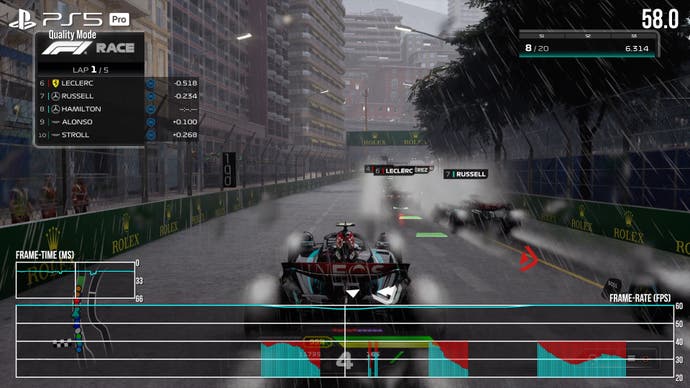
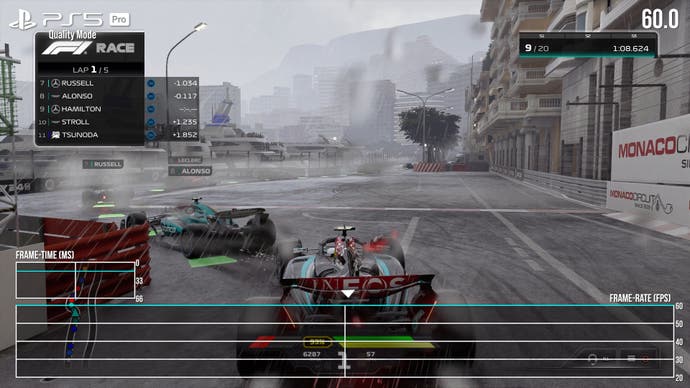
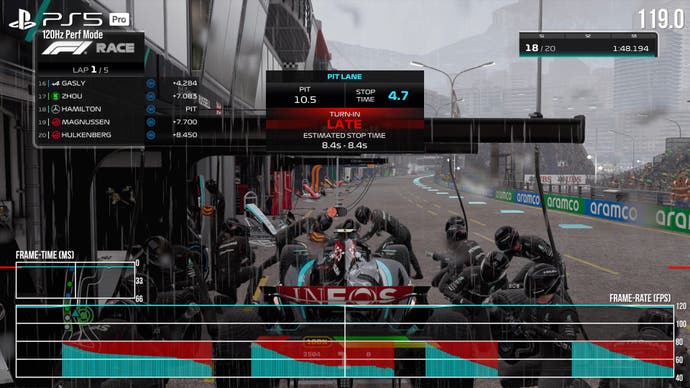
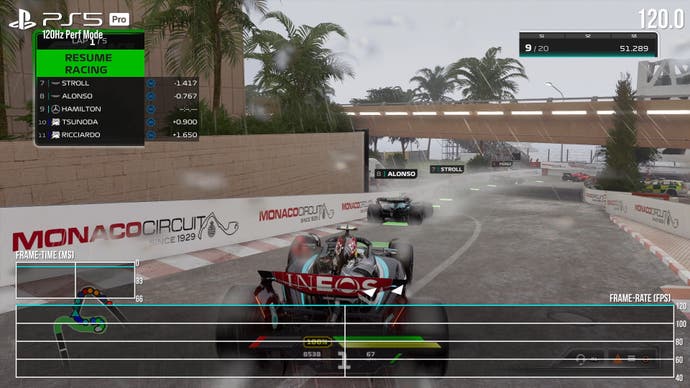
Testing PS5 Pro’s frame-rate at 120fps, the turnout is capably hits the mark. On every track tested so far there’s barely a blip en route, even including the Monaco circuit as our extreme stress test. That said, there are some exceptions. Turning into a pitstop for repairs triggers a minor bout of frame drops – to 115fps lowest, with full-screen tearing. There’s also very occasional one frame drops during gameplay, but nothing that massively detracts from the experience. And once again, performance mode has an odd set of behaviours during pre-race sequences and replays. Generally these lock at a 40fps cap much like the quality mode (and 40fps makes much more sense with 120Hz as the output here), but ending or retiring from a race triggers the engine to run fully unlocked to 120 frames per second. Much like base PS5, these automated, post-race moments engage ray tracing for ambient occlusion, reflections and DDGI. The net result is, we get to see – even if just briefly – how PS5 Pro would run with these RT technologies with a 120fps target. The reality is that we’re hovering at the 70-90fps range, and that being the case, disabling these options for gameplay itself seems a sensible call.
Finally, let’s talk about the 8K resolution mode. The idea is, you set the PS5 Pro at a system level to output at 8K, and from there, the new resolution option unlocks on the F1 24 menus. This forces the game to render at a native 4K, which is then upscaled using the EGO engine’s TAAU to create an 8K image. Based on TV eyeballing alone, it’s impressive up to a point. While still at the starting grid, fine detail like fences resolve to a convincingly sharp 8K frame and the impression is of an ultra-resolution presentation. Equally, any slow cornering holds up well in the upscale to 8K – and all the HUD and menus look as sharp as you’d hope. The effect does break a little while in motion, perhaps; it degrades, though it’s unclear how much of this is owed to the quality of TAAU reconstruction, or the display we demoed it on. Impressively, the 8K mode also engages DDGI and Codemasters states it is potentially looking into getting PSSR in place as the upscaler of choice in the future, if possible. Even with TAAU though, first impressions are good – and we’ll have more to say on PS5 Pro’s 8K support when the console lands.
What’s impressive about F1 24 is how Codemasters is tapping into the balance of features available on PS5 Pro, cherry-picking for best results. Practically speaking, Codemasters targets the ray tracing tech that shows off best while in gameplay – reflections, AO and DDGI. The other big success is that 60fps is kept in place for this mode, and, thanks to PSSR, a 4K image is still viable using reconstruction. It’s a solid, early use-case for PS5 Pro then, as a way to demonstrate its core features. And even if PSSR hasn’t yet rolled out to all modes in F1 24, it’s already proving to be a handy tool, allowing Codemasters to dip into the kinds of visual features previously reserved for higher-end PC hardware. It’s an impressive showcase for PS5 Pro and we look forward to checking out the final patch on retail hardware.
fbq('init', '560747571485047');
fbq('track', 'PageView'); window.facebookPixelsDone = true;
window.dispatchEvent(new Event('BrockmanFacebookPixelsEnabled')); }
window.addEventListener('BrockmanTargetingCookiesAllowed', appendFacebookPixels);










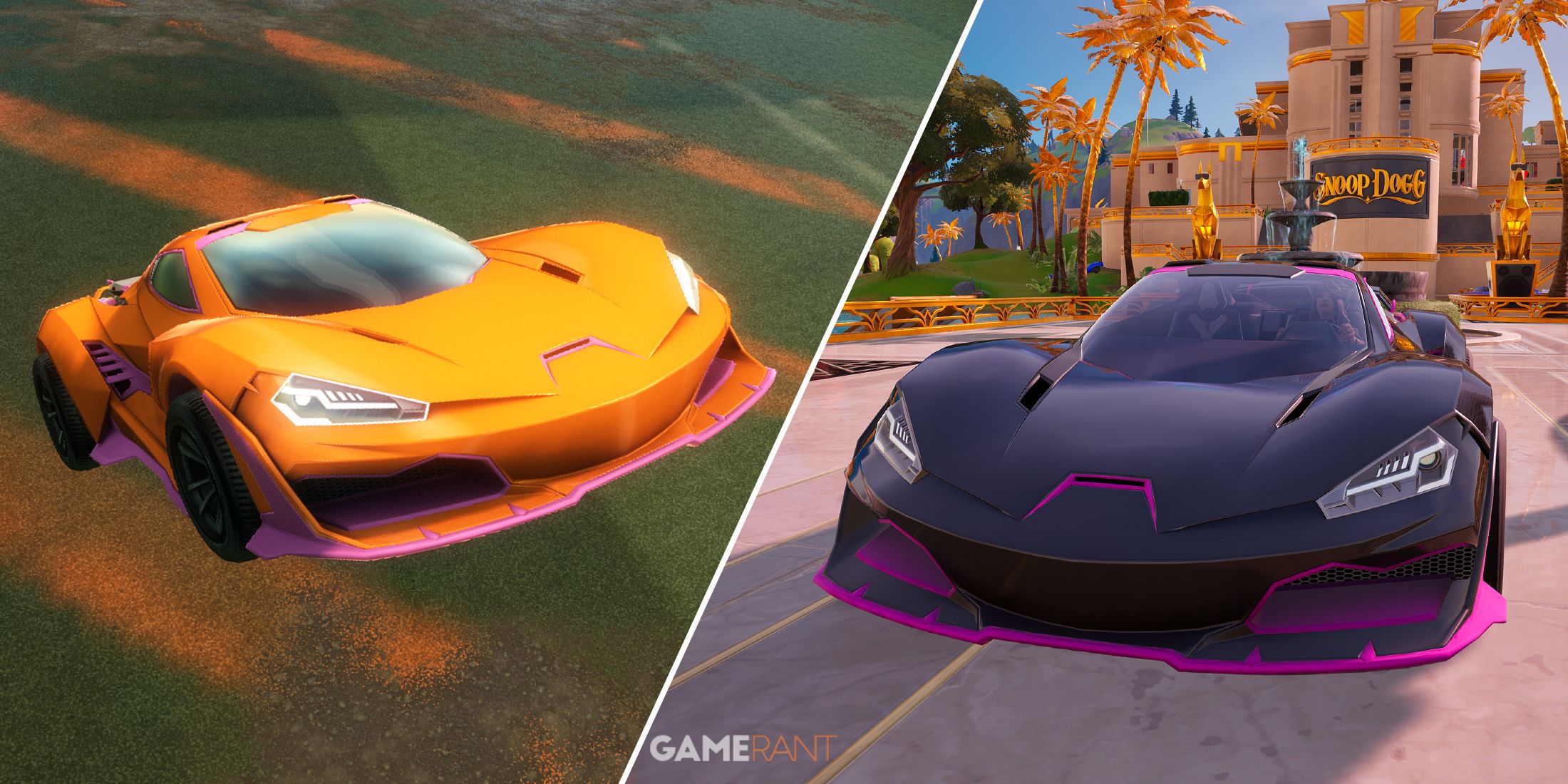
Leave a Reply